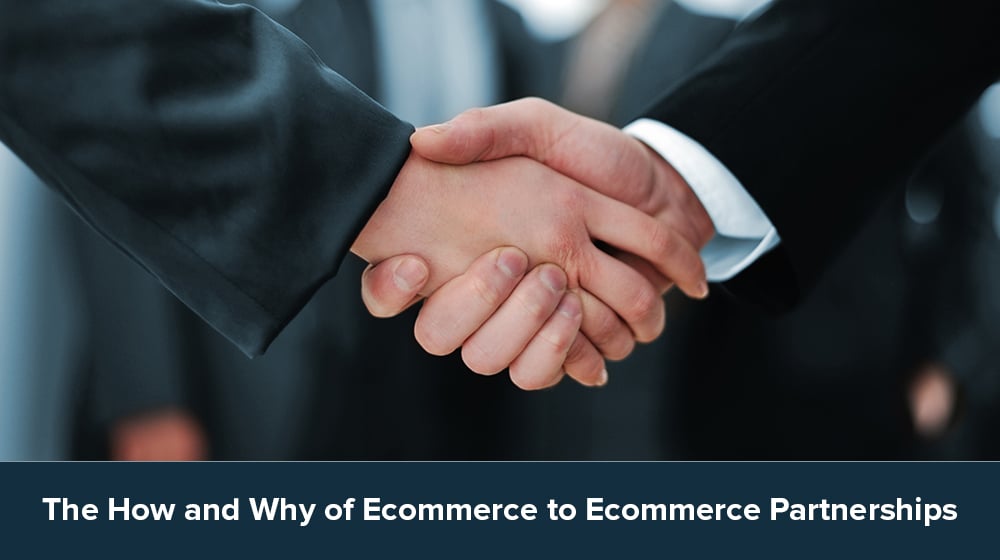Creating eCommerce partnerships is a conversion optimization strategy often set aside or forgotten, although proven effective throughout the years.
Being a successful Internet business requires more than a well-designed website, mobile apps, or even a top-tier product; you need partners.
The topic of forming effective partnerships is often overlooked when compared to the vast literature available on search engine optimization, affiliate marketing, social media marketing, cloud computing, and software-as-a-service. But then, maintaining effective eCommerce relationships is integral to a successful business strategy. This enables both parties to create configurations of products and various marketing campaigns that would not otherwise be possible.
Let us start with understanding what Ecommerce partners and ecommerce partnerships are.
What is Ecommerce Partnership?
An Ecommerce partner is the second party in an agreement specializing in any particular form of marketing. The agreement formed between you and the second party is called an ecommerce partnership. If you are an ecommerce seller or a venture and want to work in an internet marketing industry, then understanding ecommerce partnerships and their benefits is crucial for your business.
Why you should consider eCommerce to eCommerce partnerships?
Forming eCommerce to eCommerce partnerships becomes relevant for aggressive and competitive businesses or just starting out. For those who fall into the latter category, you may realize that so many tasks need to be completed as part of the process. Sometimes you and your team do not have the workforce, time, or other resources to get all of them done in time, if at all.
Read This: 101 Mobile App Ideas for startups in 2021
Winning eCommerce partnerships allow for greater potential than what could be accomplished by both parties on an individual level.
Through collaborative marketing efforts, eCommerce partners can multiply the value of their products exponentially, with double the marketing power to support their efforts.
For example, eCommerce platform developer Magento has solution partners handling sales and promotions and employing industry partners to extend and augment their services.
Celebros, which provides eCommerce technologies for online retailers, has partnerships at several levels, from service, platform, and web analytics providers.
Even alliances between unlikely parties or even direct competitors can become realized. In eCommerce today, alienating the competition is incompatible with success, and collaboration is the key to the evolution of eCommerce as a whole.
Partnering with another brand is a good way to develop a strong relationship with them for future endeavors. And when your partners’ customers see that your peers view your business in a positive light, they become your customers as well.
Collaborative marketing is the process of aligning the interests and resources of your company with other companies, allowing you to accomplish far more than you would on your own.
What are the benefits of Ecommerce Partnership?
1. Exposure
Larger, more visible companies are often at the point in their existence where their authenticity and credibility may be called into question. At the same time, smaller companies are simply looking to gain mainstream exposure and visibility. Social media and the advancement of Internet technologies have leveled the playing field, eliminating barriers to accessibility and reach across different demographics.
2. Credibility
For smaller companies, getting a large brand as a partner gives a major boost to their credibility. It shows consumers that the bigger companies are probably aware of something valuable in their smaller partners. Meanwhile, although large brands have the luxury of experience, success, and growth, they are also often viewed as greedy, power-hungry, or detached from their customer base, i.e. regular people.
Credibility works both ways, increasing brand recognition, customer value, and customer retention for all partners in the collaboration. One platform where collaborative marketing is celebrated is Etsy, where individual niche artists and small businesses join forces to create unique products for their customers.
3. Umbrella Merchants
Large brands and distributors can act as umbrella merchants, helping smaller brands develop a following and credibility while improving the customer experience. A prime example of this is the eCommerce retailer Amazon. Small businesses under them can thrive with a worldwide customer base, stable order processing infrastructure, global coverage for customer service, and other features. In turn, Amazon needs its business partners to contribute to Amazon’s catalog of products and give them exposure, albeit indirectly by promoting their own products to their markets on an individual basis.
How to establish effective eCommerce partnerships?
At this point, you are probably convinced of the benefits of eCommerce to eCommerce partnerships for your brand.
Read This: Mobile App Development Cost Report 2020
Now the next step to contemplate upon is what sort of steps should be undertaken to establish effective and rewarding eCommerce partnerships:
1. Set a goal
The first thing to do is to determine what kind of ecommerce partnership you’re seeking and what you want to accomplish. Are you looking to develop new products and services? Expand your customer base? Doing this can help you focus on which ecommerce partners to seek out and what this ecommerce partnership should be about.
2. Make your website marketable
Before looking to others for eCommerce partnerships, however, start with yourself. What does your company have to offer other companies?
Your eCommerce business must have an established brand, no matter how small or new it is. The company must have a brand, an identity, and a logo. Your website must be polished and professional with the literature on your company, including a profile and an organized structure.
Promote your business website to your prospective partners on your own web page. Give them some insight into your monthly website traffic, product range, as well as your reach.
Your website should have a thorough “About” page, and it helps to have photos of the members of your team. Use easy-to-identify visual aids, client logos, and badges that demonstrate your commitment to the quality of your products and services on your website. Emblems that state guarantees, warranties, and accreditations, as well as Internet privacy and payment security, give your viewers the confidence to place their trust in your company.
Testimonials from your clientele can also give your prospective partners a sense of the strength of your marketability in the industry. You can either include this on a specific page of your website or on a few selected pages.
See Shopify’s ‘sell clothes online’ page for reference on an effective on-site brand/partnership promotion.
3. Research
Although your website may be attractive enough to impress your current client base, potential partners won’t just flock to you. You have to take the initiative. To choose the right partners, you need to consider a few factors:
- Relevance. Successful eCommerce partnerships come from businesses in the same niche. For example, if you run an online store for pet accessories, you can partner up with businesses that focus on pet food, training, and other products. Stay away from direct competitors, since you run the risk of sending customers their way instead of yours.
- Audience. Is the audience of your prospective partner compatible with your partnership goal? Your audiences don’t need to overlap, but if both companies can serve the audiences of the other, then there is true value in the relationship.
- Opportunity. Is there an opportunity for a win-win relationship? Ask yourself what you can offer your potential ecommerce partners. Determine if the services or resources you can bring to the table are what your potential partners need.
4. Contact
Take advantage of the different social media platforms such as Facebook, Twitter, Linkedin, email, and contact form on their website to make the first move. If possible, arrange a face-to-face meeting, Skype call, or instant message conversation to discuss matters in real-time.
5. Proposal
Explain what brought you to your prospective partner’s website, and how their business can benefit from partnering with you. Elaborate your value proposition, which should achieve the following goals:
- Explains how your product is relevant to your prospective partner. It also shows how the partnership could solve the problems of both of your customers, or improve their situation
- Delivers specific, quantifiable benefits
- Tells the ideal customer what makes your company uniquely qualified to suit their needs, setting you apart from others like you
Read This: Software Development Life Cycle
Some activities that you might propose to your eCommerce partners may include the following examples:
- Joint PR initiatives, such as competitions, giveaways, and events
- Co-sponsorships
- Email cross-promotions
- Social media shout outs
Content features, e.g. creating posts that include links to their website, and vice versa
6. Make it formal
One of the biggest makes that eCommerce partners make is not having any written agreement signed by both parties. This could lead to one or both parties not fulfilling their agreed responsibilities.
Make sure to draft a contract explicitly outlining the responsibilities of both parties before implementing the partnership. This contract should cover the following items:
- The names of the parties involved
- How much time, money, and resources each business puts in
- The exact exposure each business receives
- The exact advertising/events involved in the project
- What the contingency plan would be, should anything go wrong
- When payment is due, and to whom
- When the project is to be completed, even if the date is an estimate at the time of signing.
7. Implementation and adaptation
Your final step is to enact the terms of the alliance outlined above. Keep track of your progress and the development of the partnership by keeping accurate notes and getting feedback from the other participants. Gather and track any quantitative data and statistics that can be measured and analyzed to show progress or improvement in either or both parties’ growth since the start of the relationship.
Additionally, conduct another meeting to decide how you might do things differently on the next collaboration. Yesterday’s marketing venture may already be outdated, and it’s in your best interest to keep an open mind about how to adapt your collaborative efforts to fit current trends and models.
How have your eCommerce to eCommerce relationships worked out for you so far? Let us know by leaving a comment below.








